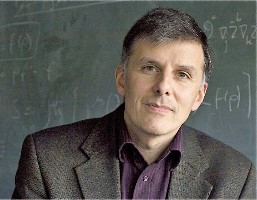Carlo Beenakker
(A Brief Biographical Sketch)
 Professor Carlo Beenakker was born in Leiden (The Netherlands) on June 9, 1960. Both his parents were physicists (his Italian mother met her Dutch husband at a summer school in the United States). He studied physics at Leiden University, earning a Ph.D. degree in 1984 on the theory of many-body hydrodynamic interactions in colloidal suspensions. After a postdoctoral year in Stanford and Santa Barbara (USA) he joined the Philips Research Laboratories in Eindhoven (The Netherlands). He returned to Leiden University in 1991 as professor of theoretical physics at the Lorentz Institute, a chair he holds to this date. His marriage in 1983 has been blessed with four children and six grandchildren.
Professor Carlo Beenakker was born in Leiden (The Netherlands) on June 9, 1960. Both his parents were physicists (his Italian mother met her Dutch husband at a summer school in the United States). He studied physics at Leiden University, earning a Ph.D. degree in 1984 on the theory of many-body hydrodynamic interactions in colloidal suspensions. After a postdoctoral year in Stanford and Santa Barbara (USA) he joined the Philips Research Laboratories in Eindhoven (The Netherlands). He returned to Leiden University in 1991 as professor of theoretical physics at the Lorentz Institute, a chair he holds to this date. His marriage in 1983 has been blessed with four children and six grandchildren.
In 1987, while at Philips Research, Carlo Beenakker contributed to the discovery and explanation of conductance quantization in a quantum point contact, for which he shared the Royal Dutch Shell prize (1993) with his colleagues Henk van Houten and Bart van Wees. In Leiden he continued his research on quantum transport in nanostructures, honored with the Spinoza prize (1999), which is the highest scientific award in the Netherlands, the Physica prize (2003), and the AKZO Nobel Science Award (2006) “for his pioneering work in the field of nanoscience”.
Carlo Beenakker has worked on a great variety of topics involving the electronic properties on the nanoscale, first dealing with conventional electrons in semiconductor two-dimensional electron gases, then with massless Dirac fermions in graphene and topological insulators, and more recently with Majorana fermions in superconductors. He also made a substantial contribution to establishing the basic concepts of single-electron tunnelling, the Coulomb Blockade and noise in mesoscopic systems, and the transport theory of the Quantum Hall effect. He developed the theory of random matrices, originating from nuclear physics, into a powerful and versatile tool for the study of quantum transport. His recent research focuses on ways in which Majorana modes can be used for topological quantum computations, in close collaboration with the QuTech laboratory in Delft.
Professor Beenakker has co-authored over 350 publications and is recognized by the Web of Science as a “Highly-cited Researcher”. He is an outstanding speaker and is frequently invited to attend international conferences and give plenary talks. He is known also as an inspiring teacher and supervisor of PhD students and postdocs that attracts highly talented young people, including those from Ukraine, to his research group. He has been elected member to the Royal Netherlands Academy of Arts and Sciences (2002) and knighted in the Order of the Dutch Lion (2015). In 2018 he was awarded an honorary doctorate by the Bogolyubov Institute for Theoretical Physics of the National academy of sciences (Ukraine).
Representative review articles include:
- Quantum point contacts (with H. van Houten), Physics Today 49 (7), 22 (1996).
- Random-matrix theory of quantum transport, Rev.Mod.Phys. 69, 731 (1997).
- Quantum shot noise (with C. Schönenberger), Physics Today, 56 (5) 37 (2003).
- Andreev reflection and Klein tunneling in graphene, Rev.Mod.Phys. 80, 1337 (2009).
- Search for Majorana fermions in superconductors, Annual Review of Cond. Matt. Phys. 4, 113 (2013).